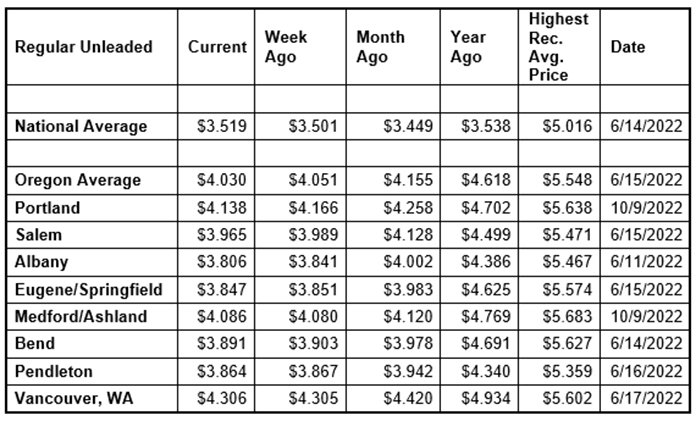Gas prices are fairly steady even as Hurricane Beryl ravaged the Gulf Coast and made landfall in southeast Texas.
While gas prices and crude oil prices didn’t see dramatic gains, this storm shows that hurricane season is off to an early start and could impact prices later this summer. For the week, the national average for regular ticks up two cents to $3.52.
The Oregon average slips two cents to $4.03 a gallon.
“We’ll likely continue to see small changes in gas prices in the short-term, barring unforeseen events. Hurricane season usually peaks in August and September, and a major storm can cause pump prices to spike if a storm impacts drilling and refining in the Gulf Coast,” says Marie Dodds, public affairs director for AAA Oregon/Idaho.
The national and Oregon averages are at the same prices as they were in March. This week, 16 Oregon counties have averages below $4 per gallon, same as a week ago:
- Baker $3.87
- Benton $3.78
- Deschutes $3.87
- Douglas $3.95
- Gilliam $3.90
- Jefferson $3.85
- Lane $3.84
- Linn $3.80
- Lincoln $3.82
- Malheur $3.84
- Marion $3.96
- Morrow $3.90
- Polk $3.89
- Sherman $3.93
- Umatilla $3.87
- Yamhill $3.95
The Oregon average began 2024 at $3.79 a gallon compared to $4.03 today. Its lowest price so far this year is $3.58 on February 14 and the highest is nearly $4.51 on May 1. The national average started the year at $3.11 and is at $3.52 today. Its lowest price so far this year is just under $3.07 on January 15 and the highest is just under $3.68 on April 19.
Gas prices are often fairly steady during the summer months, barring hurricanes, supply disruptions and/or geo-political events. Gas prices always rise starting in late winter through the spring as refineries undergo maintenance as the switch to summer-blend fuel occurs. The switch occurs first in California, which is why pump prices on the West Coast often rise before other parts of the country. The East Coast is the last major market to make the change to summer-blend fuel. Most areas have a May 1 compliance date for refiners and terminals, while most gas stations have a June 1 deadline to switch to selling summer-blend until June 1. Switch-over dates are earlier in California with some areas in the state requiring summer-blend fuel by April 1. Some refineries will begin maintenance and the switchover as early as February.
Quick stats
Oregon is one of 13 states with lower prices now than a week ago. Ohio (-11 cents) as the largest week-over-week drop in the nation. North Carolina (+9 cents) has the largest weekly increase. The average in California is flat.
California ($4.79) has the most expensive gas in the nation for the 19th week in a row. This is the fifth week in a row that the California average has been below $5 per gallon. Hawaii ($4.69) is second, Washington ($4.29) is third, Nevada ($4.04) is fourth, and Oregon ($4.03) is fifth. These are the five states with averages at or above $4 a gallon, same as a week ago. This week 44 states and the District of Columbia have averages in the $3-range. There is one state with averages in the $2 range this week.
The cheapest gas in the nation is in Mississippi ($2.99) and Louisiana ($3.07). No state has had an average below $2 a gallon since January 7, 2021, when Mississippi and Texas were below that threshold.
The difference between the most expensive and least expensive states is $1.79 this week, compared to $1.83 a week ago.
Oregon is one of 10 states with lower prices now than a month ago. The national average is seven cents more and the Oregon average is 13 cents less than a month ago. This is the fourth-largest month-over-month decline in the nation. Arizona (-17 cents) and California (-15 cents) have the largest monthly drops. Indiana (+24 cents) has the largest month-over-month increase.
Oregon is one of 34 states with lower prices now than a year ago. The national average is two cents less and the Oregon average is 59 cents less than a year ago. This is the second-largest year-over-year drop in the nation. Washington (-67 cents) has the largest yearly decrease. Indiana (+26 cents) has the largest year-over-year increase.










